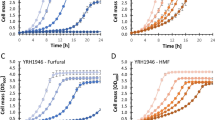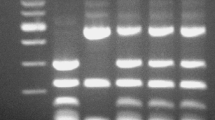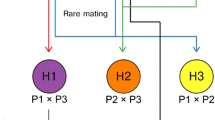Abstract
Natural Saccharomyces cerevisiae isolates from vineyards in the Western Cape, South Africa were evaluated for ethanol production in industrial conditions associated with the production of second-generation biofuels. The strains displayed high phenotypic diversity including the ability to grow at 45 °C and in the presence of 20% (v/v) ethanol, strain YI13. Strains HR4 and YI30 were inhibitor-tolerant under aerobic and oxygen-limited conditions, respectively. Spore-to-spore hybridization generated progeny that displayed heterosis, including increased ethanol productivity and improved growth in the presence of a synthetic inhibitor cocktail. Hybrid strains HR4/YI30#6 and V3/YI30#6 were able to grow at a high salt concentration (2 mol/L NaCl) with V3/YI30#6 also able to grow at a high temperature (45 °C). Strains HR4/YI30#1 and #3 were inhibitor-tolerant, with strain HR4/YI30#3 having similar productivity (0.36 ± 0.0036 g/L per h) as the superior parental strain, YI30 (0.35 ± 0.0058 g/L per h). This study indicates that natural S. cerevisiae strains display phenotypic variation and heterosis can be achieved through spore-to-spore hybridization. Several of the phenotypes (temperature-, osmo-, and inhibitor tolerance) displayed by both the natural strains and the generated progeny were at the maximum conditions reported for S. cerevisiae strains.







Similar content being viewed by others
References
Almeida JRM, Modig T, Petersson A, Hähn-Hägerdal B, Lidén G, Gorwa-Grauslund MF (2007) Increased tolerance and conversion of inhibitors in lignocellulosic hydrolysates by Saccharomyces cerevisiae. J Chem Technol Biotechnol 82:340–349
Bakker BM, Overkamp KM, van Maris AJA, Kötter P, Luttik MAH, van Dijken JP, Pronk JT (2001) Stoichiometry and compartmentation of NADH metabolism in Saccharomyces cerevisiae. FEMS Microbiol Rev 25:15–37
Balakumar S and Arasaratnam V (2012) Osmo-, thermo-, and ethanol tolerance of S. cerevisiae S1. Brazilian J Microbiol, 157–166
Basso LC, De Amorim HV, De Oliveira AJ, Lopes ML (2008) Yeast selection for fuel ethanol production in Brazil. FEMS Yeast Res 8:1155–1163
Benjaphokee S, Hasegawa D, Yokota D, Asvarak T, Auesukaree C, Sugiyama M, Kaneko Y, Boonchird C, Harashima S (2012) Highly efficient bioethanol production by a Saccharomyces cerevisiae strain with multiple stress tolerance to high temperature, acid, and ethanol. New Biotechnol 29:379–386
Bergström A, Simpson JT, Salinas F, Barré B, Parts L, Zia A, Ba ANN, Moses AM, Louis EJ, Mustonen V, Warringer J, Durbin R, Liti G (2014) A high definition view of functional genetic variation from natural yeast genomes. Mol Biol Evol 31:872–888
Billiard S, López-Villavicencio M, Hood ME, Giraud T (2012) Sex, outcrossing and mating types: unsolved questions in fungi and beyond. J Evol Biol 25:1020–1038
Camarasa C, Sanchez I, Brial P, Bigey F, Dequin S (2011) Phenotypic landscape of Saccharomyces cerevisiae during wine fermentation: evidence for origin-dependent metabolic traits. PLoS One 6:e25147
Chen Y, Sheng J, Jiang T, Stevens J, Feng X, Wei N (2016) Transcriptional profiling reveals molecular basis and novel genetic targets for improved resistance to multiple fermentation inhibitors in Saccharomyces cerevisiae. Biotechnol Biofuels 9:9
Cubillos FA, Billi E, Zörgö E, Parts L, Fargier P, Omholt S, Blomberg A, Warringer J, Louis EJ, Liti G (2011) Assessing the complex architecture of polygenic traits in diverged populations. Mol Ecol 20:1401–1413
Delfini C (1995) Scienza e tecnica di microbiologia enologica. Edizioni Il Lievito, Asti, Italy
Delfini C, Formica JV (2001) Wine microbiology: science and technology. CRC Press
Ding J, Huang X, Zhang L, Zhao N, Yang D, Zhang K (2009) Tolerance and stress response to ethanol in the yeast Saccharomyces cerevisiae. Appl Microbiol Biotechnol 85:253–263
Favaro L, Basaglia M, Trento A, van Rensburg E, García-Aparicio M, van Zyl WH, Casella S (2013) Exploring grape marc as trove for new thermotolerant and inhibitor tolerant Saccharomyces cerevisiae strains for second-generation bioethanol production. Biotechnol Biofuels 6:168
Gibson BR, Lawrence SJ, Leclaire JPR, Powell CD, Smart KA (2007) Yeast responses to stress associated with industrial brewery handling. FEMS Microbiol Rev 31:535–569
Goff SA (2011) A unifying theory for general multigenic heterosis: energy efficiency, protein metabolism, and implications for molecular breeding. New Phytol 189:923–937
Groot WJ, Sikkenk CM, Waldram RH, Lans RGJM, Luyben KCAM (1992) Kinetics of ethanol production by baker’s yeast in an integrated process of fermentation and microfiltration. Bioprocess Eng 8:39–47
Hoff JW (2012) Molecular ty** of wine yeasts: evaluation of ty** techniques and establishment of a database. University of Stellenbosch, MSc Thesis
Horváth IS, Franzén CJ, Mohammad J, Sa I, Taherzadeh MJ (2003) Effects of furfural on the respiratory metabolism of Saccharomyces cerevisiae in glucose-limited chemostats. Appl Environ Microbiol 69:4076–4086
Jönsson LJ, Alriksson B, Nilvebrant NO (2013) Bioconversion of lignocellulose: inhibitors and detoxification. Biotech Biofuels 6:16–25
Jönsson LJ, Martín C (2016) Pretreatment of lignocellulose: formation of inhibitory by-products and strategies for minimizing their effects. Bioresour Technol 199:103–112
Khan W, Augustyn OPH, van der Westhuizen TJ, Lambrechts MG, Pretorius IS (2000) Geographic distribution and evaluation of Saccharomyces cerevisiae strains isolated from vineyards in the warmer, inland regions of the Western Cape in South Africa. S Afr J. Enol Vitic 21:17–31
Klinke HB, Thomsen AB, Ahring BK (2004) Inhibition of ethanol-producing yeast and bacteria by degradation products produced during pre-treatment of biomass. Appl Microbiol Biotechnol 66:10–26
Kvitek DJ, Will JL, Gasch AP (2008) Variations in stress sensitivity and genomic expression in diverse S. cerevisiae isolates. PLoS Genet 4: 31–35
Larsson S, Palmqvist E, Hahn-Hägerdal B, Tengborg C, Stenberg K, Zacchi G, Nilvebrant NO (1999) The generation of fermentation inhibitors during dilute acid hydrolysis of softwood. Enzym Microb Technol 24:151–159
Larsson S, Quintana-Sáinz A, Reimann A, Nilvebrant NO, Jönsson LJ (2000) Influence of lignocellulose-derived aromatic compounds on oxygen-limited growth and ethanolic fermentation by Saccharomyces cerevisiae. Appl Biochem Biotechnol 84-86:617–632
Legras J-L, Karst J (2003) Optimisation of interdelta analysis for Saccharomyces cerevisiae strain characterisation. FEMS Microbiol Lett 221:249–255
Lehner B (2011) Molecular mechanisms of epistasis within and between genes. Trends Genet 27:323–331
Liti G, Carter DM, Moses AM, Warringer J, Parts L, James SA, Davey RP, Roberts IN, Burt A, Koufopanou V, Tsai IJ, Bergman CM, Bensasson D, O’Kelly MJT, van Oudenaarden A, Barton DBH, Bailes E, Ba ANN, Jones M, Quail MA, Goodhead I, Sims S, Smith F, Blomberg A, Durbin R, Louis EJ (2009) Population genomics of domestic and wild yeasts. Nature 458:337–341
Liu ZL (2011) Molecular mechanisms of yeast tolerance and in situ detoxification of lignocellulose hydrolysates. Appl Microbiol Biotechnol 90:809–825
Lu Y, Cheng YF, He XP, Guo XN, Zhang BR (2012) Improvement of robustness and ethanol production of ethanologenic Saccharomyces cerevisiae under co-stress of heat and inhibitors. J Ind Microbiol Biotechnol 39:73–80
Lynd LR (1996) Overview and evaluation of fuel ethanol from cellulosic biomass: technology, economics, the environment, and policy. Annu Rev Energy Environ 21:403–465
Lynd LR, Laser MS, Bransby D, Dale BE, Davison B, Hamilton R, Himmel M, Keller M, McMillan JD, Sheehan J, Wyman CE (2008) How biotech can transform biofuels. Nat Biotechnol 26:169–172
Lynd LR, Wyman CE, Gerngross TU (1999) Biocommodity engineering. Biotechnol Prog 15:777–793
Ma M, Liu ZL (2010) Mechanism of ethanol tolerance in Saccharomyces cerevisiae. Appl Microbiol Biotechnol 87:829–845
Martín C, Jönsson LJ (2003) Comparison of the resistance of industrial and laboratory strains of Saccharomyces and Zygosaccharomyces to lignocellulose-derived fermentation inhibitors. Enzym Microb Technol 32:386–395
Marullo P, Mansour C, Dufour M, Albertin W, Sicard D, Bely M, Dubourdieu D (2009) Genetic improvement of thermo-tolerance in wine Saccharomyces cerevisiae strains by a backcross approach. FEMS Yeast Res 9:1148–1160
Matsumoto TK, Ellsmore AJ, Cessna SG, Low PS, Pardo JM, Bressan RA, Hasegawa PM (2002) An osmotically induced cytosolic Ca2+ transient activates calcineurin signaling to mediate ion homeostasis and salt tolerance of Saccharomyces cerevisiae. J Biol Chem 277:33075–33080
Matzke MA, Mittelsten Scheid O, Matzke AJ (1999) Rapid structural and epigenetic changes in polyploid and aneuploid genomes. BioEssays 21:761–767
Meersman E, Steensels J, Paulus T, Struyf N, Saels V, Mathawan M, Koffi J, Vrancken G, Verstrepen KJ (2015) Breeding strategy to generate robust yeast starter cultures for cocoa pulp fermentations. Appl Environ Microbiol 81:6166–6176
Mhlongo SI, den Haan R, Viljoen-Bloom M, van Zyl WH (2015) Lignocellulosic hydrolysate inhibitors selectively inhibit/deactivate cellulase performance. Enzym Microb Technol 81:16–22
Mille Y, Beney L, Gervais P (2005) Compared tolerance to osmotic stress in various microorganisms: towards a survival prediction test. Biotechnol Bioeng 92:479–484
Moore JH (2005) A global view of epistasis. Nature Genet 37:13–14
Mukherjee V, Steensels J, Lievens B, van de Voorde I, Verplaetse A, Aerts G, Willems KA, Thevelein JM, Verstrepen KJ, Ruyters S (2014) Phenotypic evaluation of natural and industrial Saccharomyces yeasts for different traits desirable in industrial bioethanol production. Appl Microbiol Biotechnol 98:9483–9498
Neves M-J, François J (1992) On the mechanism by which a heat shock induces trehalose accumulation in Saccharomyces cerevisiae. Biochem J 288:859–864
Nevoigt E (2008) Progress in metabolic engineering of Saccharomyces cerevisiae. Microbiol Mol Biol Rev 72:379–412
Pavelka N, Rancati G (2013) Never in neutral: a systems biology and evolutionary perspective on how aneuploidy contributes to human diseases. Cytogen Genome Res 139:193–205
Pavelka N, Rancati G, Li R (2010) Dr. Jekyll and Mr. Hyde: role of aneuploidy in cellular adaptation and cancer. Curr Opin Cell Biol 22:809–815
Pienkos PT, Zhang M (2009) Role of pretreatment and conditioning processes on toxicity of lignocellulosic biomass hydrolysates. Cellulose 16:743–762
Piper PW (1995) The heat shock and ethanol stress responses of yeast exhibit extensive similarity and functional overlap. FEMS Microbiol Lett 134:121–127
Randez-Gil F, Sanz P, Prieto J (1999) Engineering baker’s yeast: room for improvement. Trends Biotechnol 17:237–244
Robinson J (1994) Oxford companion to wine. Oxford University Press, Oxford, United Kingdom
Rose AH (1980) Recent research on industrially important strains of S. cerevisiae. In Biology and activities of yeasts, Skinner FA, Passmore SM, and Davenport RR. (Eds). London, United Kingdom: Academic Press pp. 101–121
Salinas F, de Boer CG, Abarca V, García V, Cuevas M, Araos S, Larrondo LF, Martínez C, Cubillos FA (2016) Natural variation in non-coding regions underlying phenotypic diversity in budding yeast. Nat Sci Rep 6:21849
Salinas F, Cubillos FA, Soto D, García V, Cuevas M, Bergström A, Warringer J, Ganga MA, Louis EJ, Liti G, Martínez C (2012) The genetic basis of natural variation in oenological traits in S. cerevisiae. PLoS One 7:e49640
Salvadó Z, Arroyo-López FN, Guillamón JM, Salazar G, Quero A, Barrio E (2011) Temperature adaptation markedly determines evolution within the genus Saccharomyces. Appl Environ Microbiol 77:2292–2302
Sampredo JG and Uribe S (2004) Trehalose-enzyme interactions result in structure stabilization and activity inhibition. The role of viscosity. Mol Cell Biochem 256/257:319–327
Segrè D, DeLanu A, Church GM, Kishony R (2005) Modular epistasis in yeast metabolism. Nat Genet 37:77–83
Snoek T, Nicolino MP, van den Bremt S, Mertens S, Saels V, Verplaetse A, Steensels J, Verstrepen KJ (2015) Large-scale robot-assisted genome shuffling yields industrial Saccharomyces cerevisiae yeasts with increased ethanol tolerance. Biotechnol Biofuels 8:32–48
Stanley D, Bandara A, Fraser S, Chambers PJ, Stanley GA (2010) The ethanol stress response and ethanol tolerance of Saccharomyces cerevisiae. J Appl Microbiol 109:13–24
Steensels J, Snoek T, Meersman E, Nicolino MP, Voordeckers K, Verstrepen KJ (2014) Improving industrial yeast strains: exploiting natural and artificial diversity. FEMS Microbiol Rev 38:947–995
Storchova Z (2014) Ploidy changes and genome stability in yeast. Yeast 31:421–430
van der Westhuizen TJ, Augustyn OPH, Khan W, Pretorius IS (2000a) Seasonal variation of indigenous Saccharomyces cerevisiae strains isolated from vineyards in the Western Cape in South Africa. S Afr J Enol Vitic 21:10–16
van der Westhuizen TJ, Augustyn OPH, Pretorius IS (2000b) Geographical distribution of indigenous Saccharomyces cerevisiae strains isolated from vineyards in the coastal regions of the Western Cape in South Africa. S Afr J Enol Vitic 21:3–9
van Zyl WH, Chimphango AFA, den Haan R, Gorgens JF, Chirwa PWC (2011) Next-generation cellulosic ethanol technologies and their contribution to a sustainable Africa. Interface Focus 1:196–211
Viikari L, Alapuranen M, Puranen T, Vehmaanperä J, Siika-Aho M (2007) Thermostable enzymes in lignocellulose hydrolysis. In Biofuels (pp. 121–145). Springer Berlin Heidelberg
Viktor MJ, Rose SH, van Zyl WH, Viljoen-Bloom M (2013) Raw starch conversion by Saccharomyces cerevisiae expressing Aspergillus tubingensis amylases. Biotechnol Biofuels 6:167
Walker G (1998) Yeast physiology and biotechnology. John Wiley and Sons, West Sussex, England
Yona AH, Manor YS, Herbst RH, Romano GH, Mitchell A, Kupiec M, Pilpel Y, Dahan O (2012) Chromosomal duplication is a transient evolutionary solution to stress. PNAS 109:21010–21015
You KM, Rosenfield C-L, Knipple D (2003) Ethanol tolerance in the yeast Saccharomyces cerevisiae is dependent on cellular oleic acid content. Appl Environ Microbiol 69:1499–1503
Zaldivar J, Nielsen J, Olsson L (2001) Fuel ethanol production from lignocellulose: a challenge for metabolic engineering and process integration. Appl Microbiol Biotechnol 56:17–34
Zhao XQ, Bai FW (2009) Mechanisms of yeast stress tolerance and its manipulation for efficient fuel ethanol production. J Biotechnol 144:23–30
Zörgö E, Gjuvsland A, Cubillos FA, Louis EJ, Liti G, Blomberg A, Omholt S, Warringer J (2012) Life history shapes trait heredity by accumulation of loss-of-function alleles in yeast. Mol Biol Evol 10:1093
Acknowledgements
The authors would like to thank Lisa Wahlberg for the operation of the HPLC instrument.
Funding information
This work was supported by the National Research Foundation (NRF) to the Chair of Energy Research: Biofuels and other clean alternative fuels (grant number UID 86423 awarded to WHvZ).
Author information
Authors and Affiliations
Corresponding author
Ethics declarations
This article does not contain any studies with human participants or animals performed by any of the authors.
Conflict of interests
The authors declare that they have no conflict of interest.
Rights and permissions
About this article
Cite this article
Jansen, T., Hoff, J.W., Jolly, N. et al. Mating of natural Saccharomyces cerevisiae strains for improved glucose fermentation and lignocellulosic inhibitor tolerance. Folia Microbiol 63, 155–168 (2018). https://doi.org/10.1007/s12223-017-0546-3
Received:
Accepted:
Published:
Issue Date:
DOI: https://doi.org/10.1007/s12223-017-0546-3




